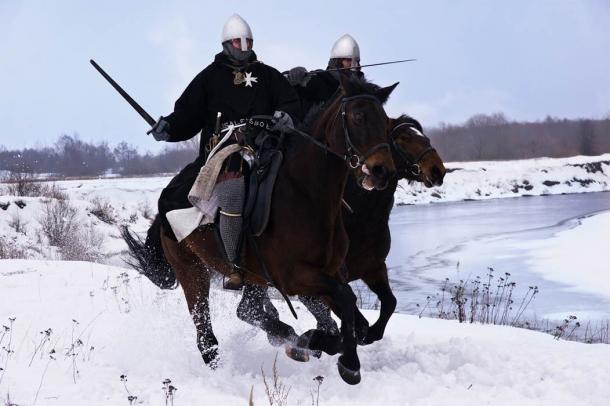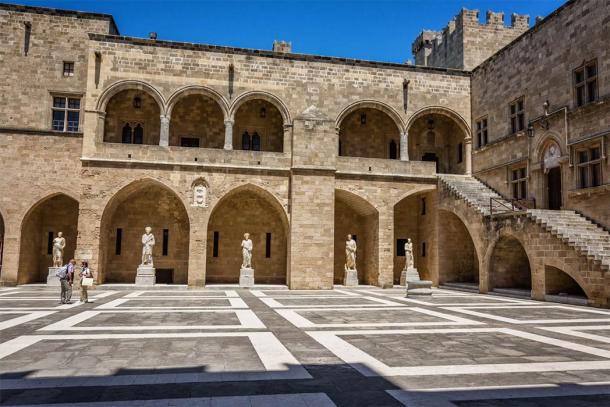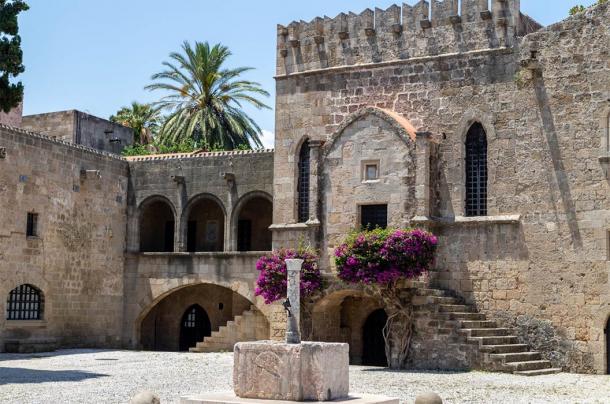The island of Rhodes which now forms part of Greece, has a long and dramatic history dating back 12,000 years to the Neolithic era. In the medieval period it was the headquarters of The Order of Knights of the Hospital of Saint John of Jerusalem as they were officially known, or more commonly, The Knights of Rhodes or Knights of St John.
During their occupation, they transformed Rhodes into a Christian stronghold , and exerted huge influence over the affairs of the Eastern Mediterranean. The medieval town has been miraculously preserved and today it is a UNESCO World Heritage site.
The History of Rhodes: Rise and Fall of Knights of St John
Rhodes is the largest of the Dodecanese islands of Greece, located in the Aegean Sea, with the town of Rhodes as the capital of the island chain. Rhodes was a significant city-state in the Hellenistic period and an important cultural center in the Roman era. Later it was controlled by the Byzantines who built fortifications in the town.
After the collapse of Byzantine power, the Genoese and Turks occupied the island. It was captured by the Knights of St John in 1310. They rebuilt the town of Rhodes and turned it into the headquarters of their order. The knights were a crusading order of warriors-monk and became known as the Knights of St John of Rhodes. They took religious vows to protect Christians and to fight the enemies of Christ.

The Order of Knights of the Hospitallers of St John ( Demian / Adobe Stock)
The knights surrounded Rhodes with strong walls and they preyed on Muslim ships in the Eastern Mediterranean from the island. They became the terror of the Muslim world and were often little more than pirates.
The Egyptian Sultan besieged Rhodes in the late 14th century but the knights managed to beat back his army. In 1480, they also survived a siege by the Ottomans led by Mehmet II. In 1522 the Ottomans, under Suleiman the Magnificent attacked the knights in their stronghold. He surrounded it with an army of 100,000 men and after a brutal six-month siege, forced the Knights of Rhodes to surrender. Those who survived went to Malta and turned it into their new bastion. They became known as the Knights of Malta.
Under Ottoman occupation Rhodes prospered for many centuries. Although they added many Islamic monuments to the town, this did not alter the medieval town’s character . In 1912 the Italians seized the island from the Turks and in 1945, Rhodes only became part of Greece.
The Character of the Medieval Town of Rhodes
The medieval town is surrounded by walls 2.5 miles (4 km) long, which are among the most impressive built in the Middle Ages. These walls were built upon the remains of Byzantine ramparts.
The Grand Masters added several artillery positions and platforms in the 1500s which can still be seen. Just before the last siege, the knights added a section to the walls known as the Gate of Amboise. This grand entrance has holes for cannons which were used in the siege of 1522. They used western European building technology which was superior to anything in the eastern Mediterranean and as a result, their fortress was considered impregnable.

The Palace of the Grand Master in Rhodes, Greece ( Kateryna / Adobe Stock)
The town is divided into the lower and the upper town, with the two areas divided by a sturdy wall in the Middle Ages. The upper area was the bastion of the knights, constructed by the crusading order in a Romanesque and Gothic style and as a result, became known as the ‘Frankish Town’. The famous Street of the Knights is lined with inns, palatial residences, of the various nationalities who served the order. Perhaps the most famous is the one known as the Inn of the Tongue of Italy. Seven nations such as French, English, Spanish and Provencal also had inns along the route. The Inn of the Tongue of Auvergne, which bears the coat of arms of Guy de Blanchefort, one of the Orders last elected Grand Masters, who sadly died on his journey to Rhodes in 1513. To the north of the Upper town is the hospice of the order.

Knights street in the old town of Rhodes city ( Reiner / Adobe Stock)
The lower town was also extensively rebuilt by the knights with many charitable institutions and palaces built in this area. Among the most impressive are the Archbishop’s Palace and a second hospice. Several Gothic churches are also to be found. Many of these were converted into mosques in 1523.
The palace of the Grand Master of the Order, the famous “Castello House”, is one of the greatest monuments erected in the Middle Ages . It was the administrative center, the residence of the leader of the Knights of St John, and the seat of the established ruling class.
Why Rhodes Island is Popular with Tourists
The island of Rhodes is popular with tourists for its incredible beauty and numerous fascinating tours of the island. No fee is charged to visit the Medieval city of Rhodes and some of the buildings have been converted to others uses. There are several museums in the medieval town, and it is possible to walk around at any time.
Top image: St John knights castle at night, Rhodes island, Greece
Source: vladimircaribb / Adobe Stock
By Ed Whelan
References
Foutakis, P. (2020). The Inn of the Tongue of Italy for the Hospitaller knights in Rhodes . Post-Medieval Archaeology, 1-23
Available at: https://www.tandfonline.com/doi/abs/10.1080/00794236.2020.1750152
O’Connell, M. (2006). The Town of Rhodes: 1306-1356
Available at: https://www.jstor.org/stable/20463885
Zarifis, N., Manoussou-Della, K., Dellas, G., Papatheodorou, P., Paraskevopoulou, A., Anapolitanos, T., & Lazaridou-Koliadi, D. (1989). Medieval town of Rhodes. Restoration and its problems. In Structural Conservation of Stone Masonry = Conservation Structurelle de la Maçonnerie en Pierre (pp. 503-512)
Available at: https://www.bcin.ca/bcin/detail.app?id=103261&wbdisable=true
Related posts:
Views: 0
 RSS Feed
RSS Feed

















 November 13th, 2020
November 13th, 2020  Awake Goy
Awake Goy 




 Posted in
Posted in  Tags:
Tags: 
















